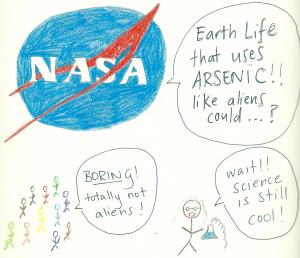The arsenic post I never wrote
I never wrote what I meant to here – I simply could not keep up with the rest of the blogs regarding arsenic life! But I’m also aware that outside of the sci-twitter bubble, what went down may not be entirely clear, so here’s the beginning of the draft just in case you need to catch up.
Reactions to NASA’s announcement of “arsenic-based life” have been resounding through the science world these past few weeks. (For more thorough reviews, check out Bora Zivkovic’s link dump, Martin Robbins’s coverage, or the National Association of Science Writers.) For those who haven’t been scouring all the blogs, I’ve illustrated a brief review of events.
The saga began with a NASA press release announcing a press conference about a discovery about “an astrobiology finding that will impact the search for evidence of extraterrestrial life.” This led to speculation about aliens – life on Titan? – and then, when it was uncovered that the study was written by scientists studying the arsenic-rich Mono Lake in California, perhaps the researchers discovered a “shadow biosphere” – a form of life unlike ours, based on different molecules and evidence of a novel evolution of life on earth.
The actual paper, published in Science, instead announced that the scientists had found a bacterium that, when forced in a lab, could utilize arsenic in place of phosphorus in its molecules, including DNA. After the hype and build-up, it was a disappointing announcement. Due to the massive let-down, a lot of writers and scientists (myself included) chose to accept these findings instead of scrutinizing them. It is a bit embarrassing in hindsight, but after so much hype about a scientific discovery that engaged the public, I wanted to find something to stay excited about, if only to support the idea that science isn’t a complete sham.
Soon after, scientists began to carefully look at the researchers’ methods and found that these findings simply weren’t very well-supported. For the details, I recommend Rosie Redfield’s highly-publicized critique as well as Alex Bradley’s on We Beasties. The researchers’ evidence could easily have been contaminated, and they failed to do some fairly simple tests to definitively show the use of arsenic by these microbes. At this point, most media sources threw up their hands in frustration and stopped covering the story. (For more detail, see Carl Zimmer’s Slate piece, “This Paper Should Not Have Been Published.”)
This series of events led to some interesting reflections around the blogs, including thoughts on the peer review process, the scientific process, and the upside of public scientific debate. The authors’ refusal to engage the bloggy criticisms (even though they used the web to get everyone hyped about their discovery) got everyone into an uproar as well, as described in this open-access Nature editorial.









I love love love the illustrations!
Zen Faulkes
December 16, 2010 at 10:19 am
[…] Culturing Science – biology as relevant to us earthly beings Skip to content HomeAboutAwards and MentionsPhilly Science EventsPrimersDNA BasicsPopulation Ecology: The BasicsProtein Synthesis BasicsWorks CitedCulturing Science – Index by AuthorCulturing Science – Index by JournalCulturing Science – Other Papers Cited ← The arsenic post I never wrote […]
Purpose in scientific research | Culturing Science – biology as relevant to us earthly beings
December 16, 2010 at 12:08 pm
[…] This post was mentioned on Twitter by Bora Zivkovic and Hannah Waters, Hannah Waters. Hannah Waters said: A basic, illustrated guide to #arsenic life: The arsenic post I never wrote http://bit.ly/h9dOTc […]
Tweets that mention The arsenic post I never wrote | Culturing Science – biology as relevant to us earthly beings -- Topsy.com
December 16, 2010 at 12:13 pm
I never wrote what I meant to here – I simply could not keep up with the rest of the blogs regarding arsenic life!
Know the feeling :-) In a similar way I have probably at least half a dozen follow-ups on the the various aspects of science reporting, peer reviews, etc., that I would write were it not for the maddening end-of-year rush. (IRL, that is.)
Grant
December 16, 2010 at 2:18 pm
[…] life? and Response required and More on Arsenic Bugs – Nature responds to the blogosphere and The arsenic post I never wrote and What Alien Bacteria Can Teach Us About Health PR and Response to Questions Concerning the […]
Quick Links | A Blog Around The Clock
December 16, 2010 at 11:37 pm
[…] The arsenic post I never wrote and What Alien Bacteria Can Teach Us About Health PR and Response to Questions Concerning the Science Article, A Bacterium That Can Grow by Using Arsenic Instead of Phosphorous (PDF) and Real science – warts and all […]
Arsenic Bacteria link-dump | A Blog Around The Clock
December 16, 2010 at 11:41 pm
[…] over all the arsenic-based life news? Hannah at Culturing Science has an easy to read post on how it all went down (and is still going) with some amazing […]
Some Links 12.17 « Zoologirl's Blog
December 17, 2010 at 2:28 pm
It is indeed depressing. I would probably have been satisfied had I initially understood that they were talking of forcing the replacement. Then, the controversy regarding methodology would somehow have been “science proceeding apace”.
Anyway, I also really love your illustrations here. Make more of them. — GeePawHill
Mike Hill
December 19, 2010 at 11:09 am
[…] Hannah Waters. Dec 16 2010. The arsenic post I never wrote. Culturing Science. https://culturingscience.wordpress.com/2010/12/16/the-arsenic-post-i-never-wrote/ […]
#ArsenicLife Compendium « biologicalhominin
November 18, 2011 at 5:55 pm